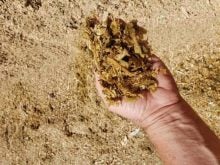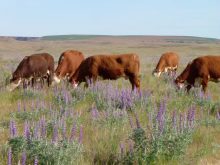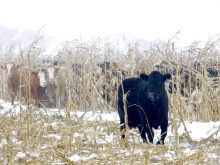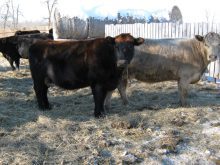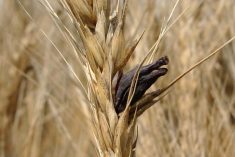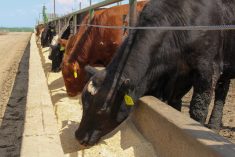Corn-dried distillers’ grains solubles (DDGS) have drawn a lot of attention among beef producers in Western Canada this year. That’s because a lack of good-quality forages caused by one of the worst droughts in years as well as high grain/protein-concentrate prices have created an easy choice for feeding this nutritious supplement to cattle. And it doesn’t stop there. DDGS has good economic value based upon its nutrients as compared to other feedstuffs. This can help cap feeding costs in our present challenging markets.
I always remind myself that DDGS is not an unavailable or exotic feed ingredient, but simply common grain corn in which its large starch component (65 per cent by weight) is removed and later fermented to make ethanol. For example, one bushel of grain corn (56 lbs.) yields 2.8 US gallons of ethanol and about 18 lbs. of dried DDGS.
Read Also

Harvest wraps up and fall work begins
At the Eppich famly ranch in western Saskatchewan, the fall harvest was successful with few breakdowns, cows and calves have been sorted and a new tractor has arrived
This causes the nutrient level in DDGS to literary triple — eight to nine per cent crude protein in grain corn becomes 27-28 per cent in DDGS and the 0.35 per cent phosphorus in whole corn is now about one per cent. Similar three-times increases can be found in its fat levels, which when combined with its digestible fibre, makes corn distillers’ grain equal to the dietary energy of grain corn or 75 per cent TDN on a dry matter intake (DMI) basis. In addition, the transformation of corn into DDGS retains the grain’s great palatability, which in the latter still contributes to good overall cattle feed consumption.
Therefore, when DDGS is fed as a viable dietary energy source for cattle, it can fully or partially replace corn (or barley). It can also do the same thing, when it is used as a 28 per cent protein ingredient, and thus replace canola meal in the same diets. As a bonus, it is favoured economically, because the current price of corn is about $ 420/mt and canola meal (35 per cent CP) is about $400/mt as compared to $350/mt for a truckload of DDGS (Based on September 2021 commodity prices).
The possible cost savings in an early-gestation brood cow diet, a backgrounder-grower ration and a 120-day finisher diet are illustrated in the accompanying table (Note: barley was not fed due to its current high price of $460/mt and lack of general availability).
So based on figures in the accompanying chart below, the largest cost difference lies within the brood cow diet because lower-cost DDGS fully replaced both corn and canola meal as both an energy and protein source. The cost difference within the backgrounder and finisher diets might have been similar, but were not as prominent due to a partial replacement with DDGS. That’s because I limit DDGS in all three rations to 25 per cent (DMI basis) and by coincidence, the brood cow diet could accept a full DDGS replacement.
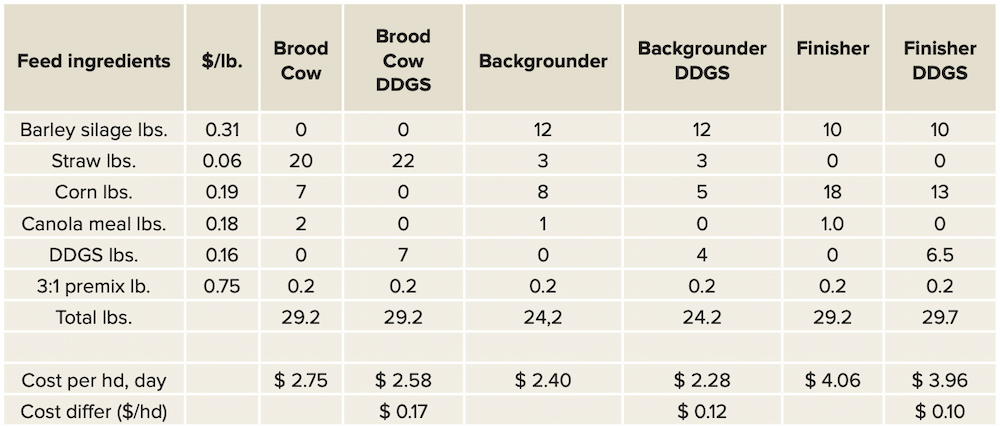
My DDGS feeding limits are also in line with those of many beef nutritionists, due to DDGS’s high sulphur content that may reach up to 1.5 per cent. So, I did not exceed a maximum tolerable sulphur level of 0.4 per cent, which has been linked to potential health problems in cattle, notably a high incidence of polioencephalomalacia (brain disorder), decreased feed intake, poor feed efficiency and copper deficiencies. Other excessive DDGS feeding has been associated with calcium ration imbalances (re: DDGS are high in phosphorus) as well as feeding too much DDGS might contribute to reduced meat shelf life, cherry-red meat colour in premium meat-cuts (ribeye) and off-flavours.
Still, high-quality DDGS is a very nutritious and palatable feedstuff for beef cattle. Its cost-saving potential as a replacement for more expensive feed ingredients in beef diets is maximized when its nutrients, namely dietary energy and protein are fully utilized. With the volatility of our grain/oilseed prices and the widespread availability of DDGS, producers should consider formulating DDGS into their beef rations in order to enjoy its economic savings.




